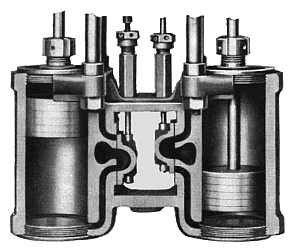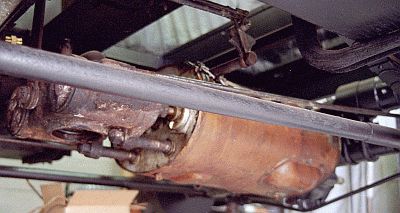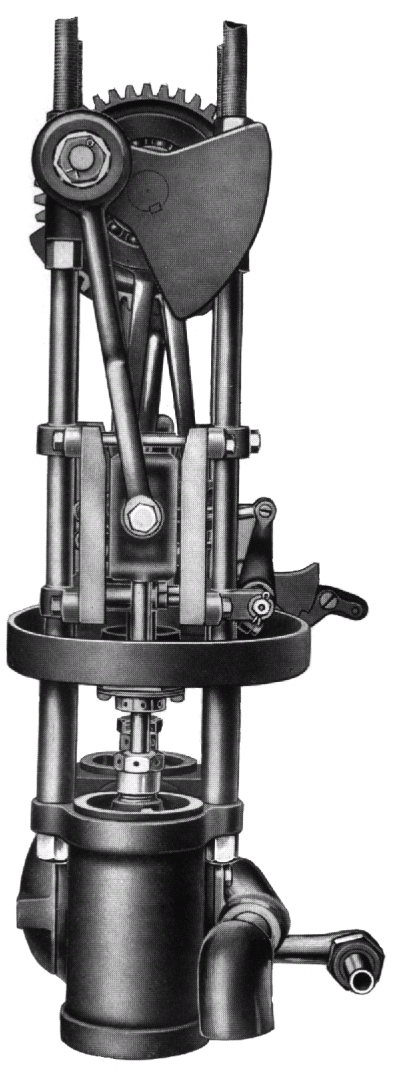|
Steam cars
unitize an external combustion (Rankine cycle) engine where the fuel source
is consumed external to the engine. The Rankine cycle
consists of six stages as follows;
1) Water is heated
at constant pressure (ideally) in a boiler.
2) The water is evaporated into a saturated vapor (known as saturated
steam).
3) The saturated steam is further heated (called superheating) to gas.
4) In the engine the gas is allowed to undergo a controlled expansion
(i.e. produces work).
5) The expanded (spent) steam is exhausted from the engine to condenser.
6) The spent steam is condensed back to water where it can repeat the
cycle.
Stanley made a number of
engine sizes over their 25 years of production. By far the most common
engine was the 20-horsepower engine used in cars made from 1910 through
1924. A 20 horsepower engine had two cylinders placed side by side and
lying lengthwise of the car. The steam is admitted to and exhausted
from the cylinders with valves located between the cylinders known as "D"
slide valves. The valve gear is Stephenson Link and is controlled from
the left driver pedal.
The piston diameter is 4
inches and the stroke each piston makes in the cylinder is 5 inches. A steam engine is the only
engine that produces maximum torque at standstill. When a Stanley's
nominal 600-pound boiler steam is applied to the two 4" diameter pistons
nearly 7 tons of force is generated to push against the crank shaft.
Both pistons are connected to a common crankshaft that has a 40-tooth gear
at the center which mates to the 60-tooth differential gear.
All the steam engines
are "double acting". This
means that pressure is applied to both sides of the piston as the engine
operates. The 4 inch piston of a 20-horsepower Stanley engine is pushed by steam to one end of the cylinder
(the cylinder is 5 inches long) and then it is pushed in the opposite direction by
steam. The internal combustion engine's pistons are only pushed
in one direction from the explosion caused by igniting the air-fuel mixture.
This means that the steam engine's pistons produce power every stroke they
make in the engine's cylinder as compared to the internal combustion engine
where the piston only produces power for 1 in 4 strokes it makes within the
cylinder. Thus in one revolution of the crankshaft, a two cylinder steam
engine like the one in a Stanley, produces as many power strokes as an 8
cylinder internal combustion engine does.
A steam boiler
generates vast quantities of power for later use on demand unlike the
internal combustion (Otto cycle) engine that must develop the needed power
on demand. A Stanley steam engine provides four power impulses per
crankshaft rotation similar to an 8-cylinder internal combustion engine.
The power is applied uniformly for a longer length of the stroke than the
hammer-like explosions common to gasoline or diesel engines. By the
piston being actuated by the cushion-like expansive force of the steam there
is less pounding and jarring of mechanical components resulting in a highly
uniform and steady application of power to the rear wheels.
Additionally,
with the internal combustion engine cylinder pressure is maximum at the
moment of fuel ignition and rapidly tapers off as the piston moves.
With the steam engine steam is admitted for up to 80% of the stroke which
provides more uniform power for a longer duration of the stroke. The
long stroke of the steam cylinder along with a continuous even push of the
piston much of the length of the cylinder provides the steam engine an
advantage of more torque in a smaller package over what can be generated
with a gasoline engine of equivalent rating.
There's
definitely more power per pound in the steam engine than in an internal
combustion engine of equivalent crank-horsepower if you neglect the boiler
generating the superheated steam. In fact it is the boiler of a steam
car that partially contributed to making them impractical. The problem
with a Rankine-cycle engine in the early 1900s was that the boiler had to be
heavy for the pressures involved. The sheer mass of steel and water
took time to heat and start generating steam. Today's metallurgical
technologies weren't available to make weight-efficient boilers.
Compounding the boiler problem was the heat source (pilot and burner) and
the inability to convert enough water into superheated steam fast enough.
It is interesting to note that the boiler problem was resolved after Stanley
went out of production with Doble introducing the flash boiler and oil
burner (the Doble vaporizing oil burner was the prototype for the modern
fuel oil heater we use to heat our homes today!). Had the Dobles
entered the steam car business at the time the Stanley's did with their
burner design we might be driving steam-powered vehicles today (this also
presupposes that the Stanley's would have teamed up with Henry Ford to
assemble cars on a production line instead of one by one by hand as the
Stanley's did).
|
 |
The steam engine in
a Stanley turns at quite a slow rate as compared to an internal combustion
engine. There is no transmission on a Stanley as the gear on the steam
engine crankshaft is directly engaged with the ring gear of the
differential. There doesn't need to be a transmission as the engine
can be stopped when the car is stopped ~ its just like a steam locomotive.
The speed a Stanley engine turns when traveling at a given speed ~ lets say
30 miles per hour ~ is actually more a function of the car's tire diameter than
anything else. For a 1918 Model 735 the tires are 36 inches in diameter giving a
circumference of 113.112". With 5,280 feet in a mile, that
equates to 63,360
inches per mile and thus means a Stanley wheel turns 560.153 times per mile
traveled. Thus, if the Model 735 were traveling along at 30 MPH, each wheel
makes 16,804.582 revolutions per hour, or is turning at a rate of 280.08
revolutions per minute! The gearing ratio between the differential gear and
the engine gear is 40 teeth on the engine gear and 60 teeth on the
differential gear giving a 1.5:1 ratio. Thus the engine must turn at a
slightly higher rate or 420.1 RPM when the car is traveling at 30 MPH.
To
look at it slightly differently, a Stanley car traveling at 30 miles per
hour has the engine turning over at a slower speed (420 RPM) than an
internal combustion engine idles at when at rest (typically 650 RPM)!
The steam engine's crankshaft is turning 840 revolutions per mile traveled (the
wheels rotate 560.153 times per mile traveled and the engine crankshaft
turns 1-1/2 times for every wheel rotation). With that slow speed
there's not much opportunity for wear of engine parts.
|
The 13 Moving Parts In A
Stanley Engine |
|
Left Piston & Piston Rod |
Right Piston & Piston Rod |
|
Left Connecting Rod |
Right Connecting Rod |
|
Left Forward Eccentric |
Right Forward Eccentric |
|
Left Reverse Eccentric |
Right Reverse Eccentric |
|
Left Slide Valve & Rod |
Right Slide Valve & Rod |
|
Left Hook-Up/Reverse Link |
Right Hook-Up/Reverse Link |
|
Crankshaft |
Note: Stanley
only counted major component assemblies. They didn't include
things such as the rollers in the 4 bearings and similar "incidental" parts. |



